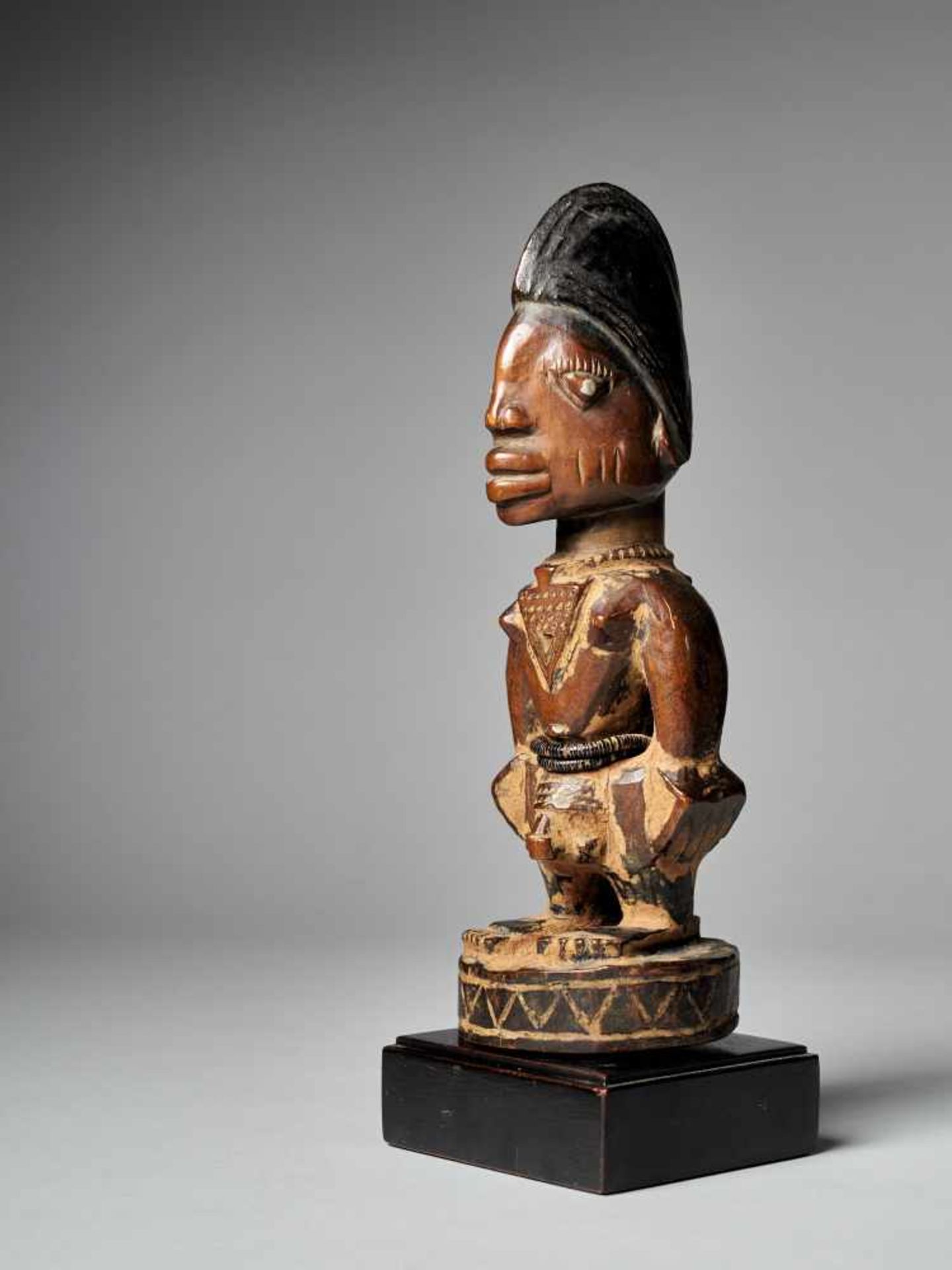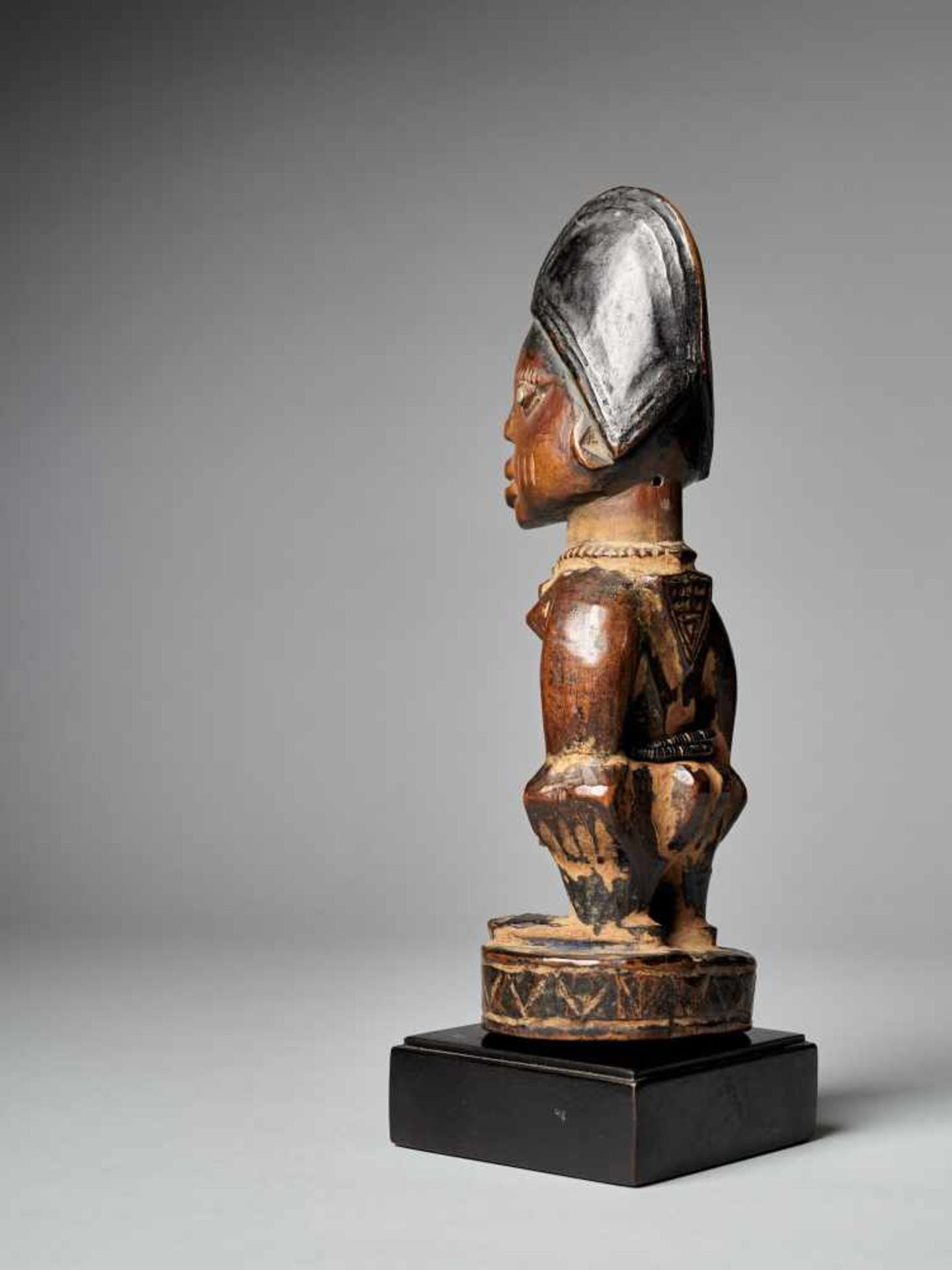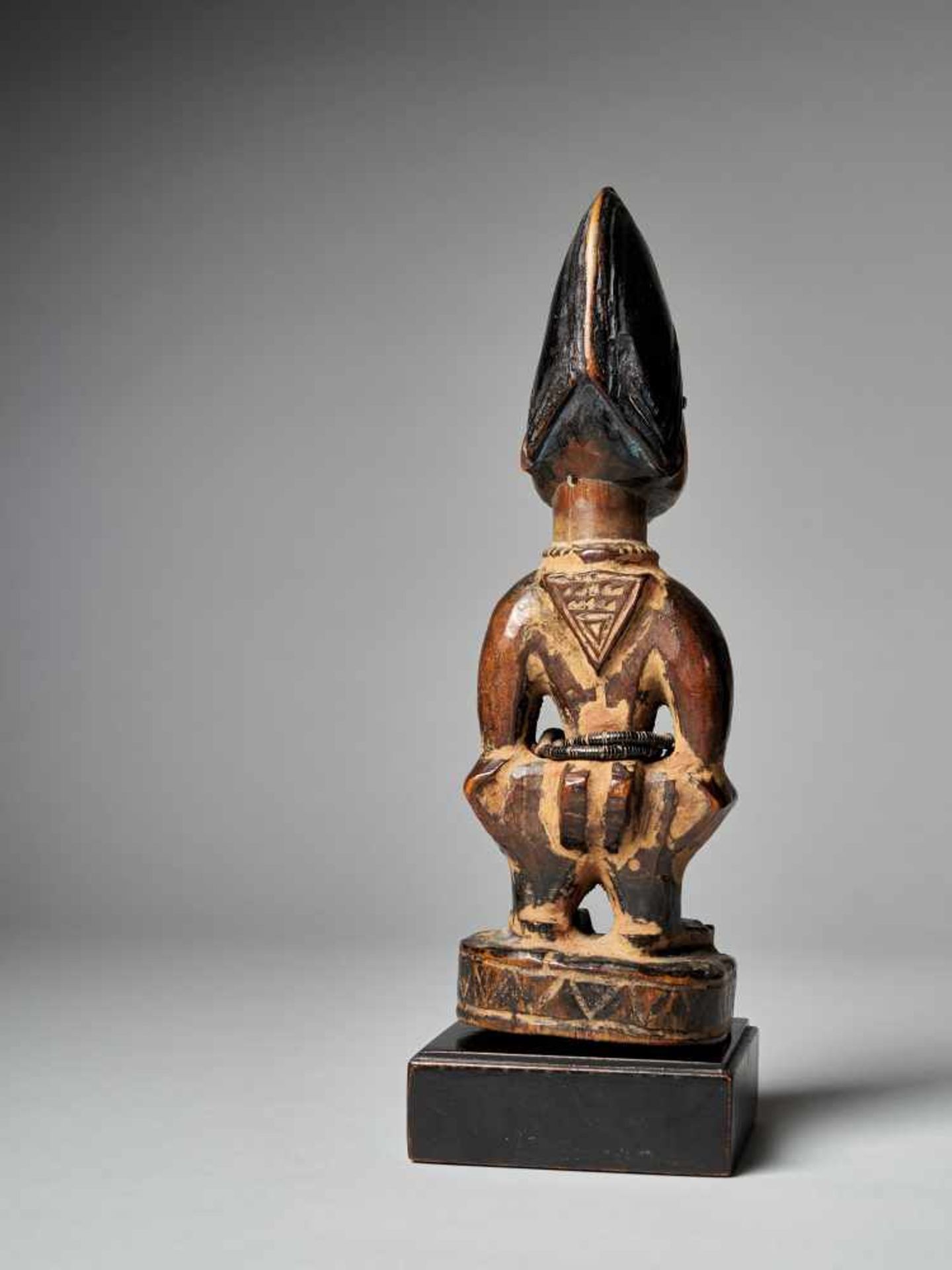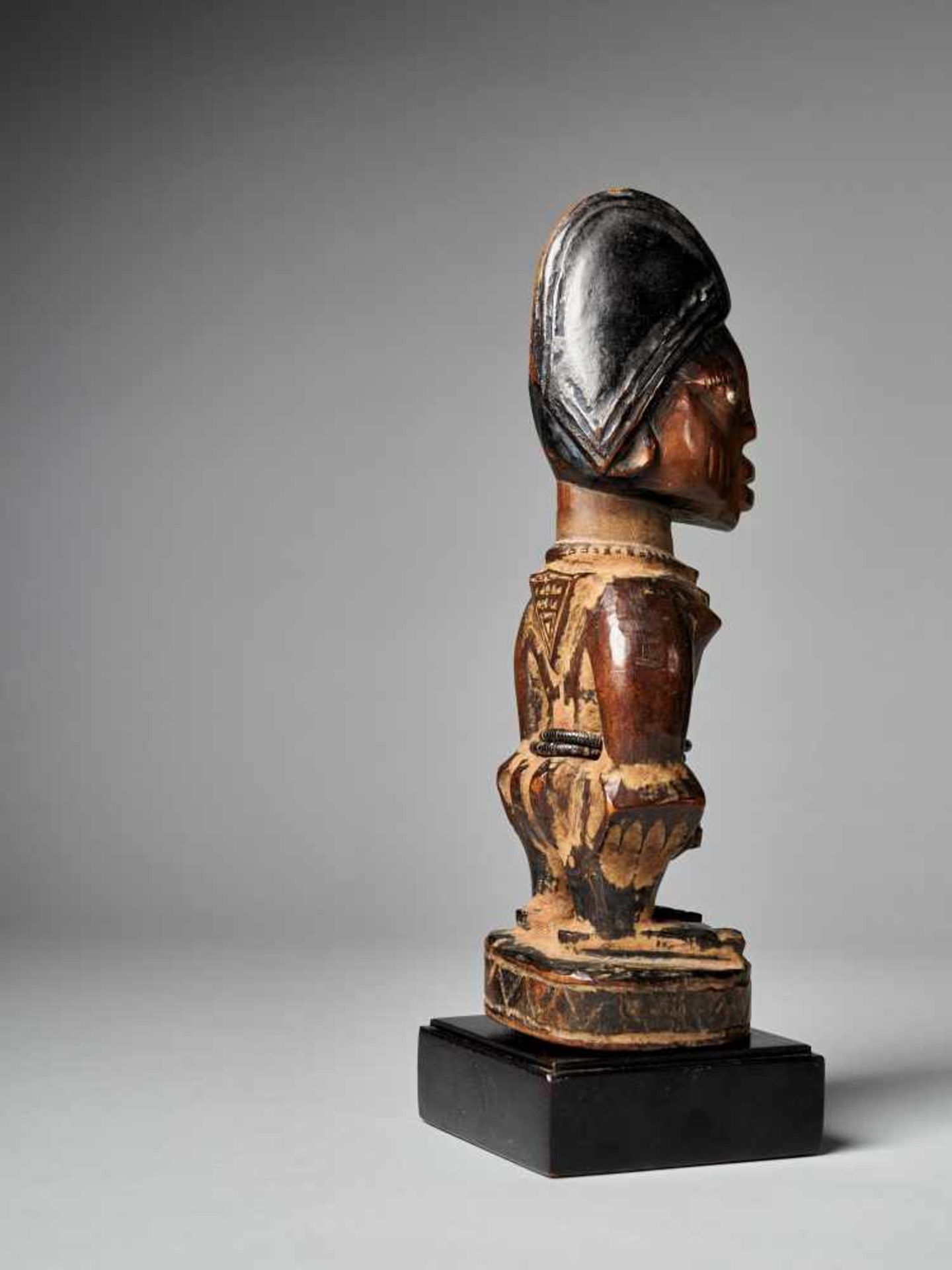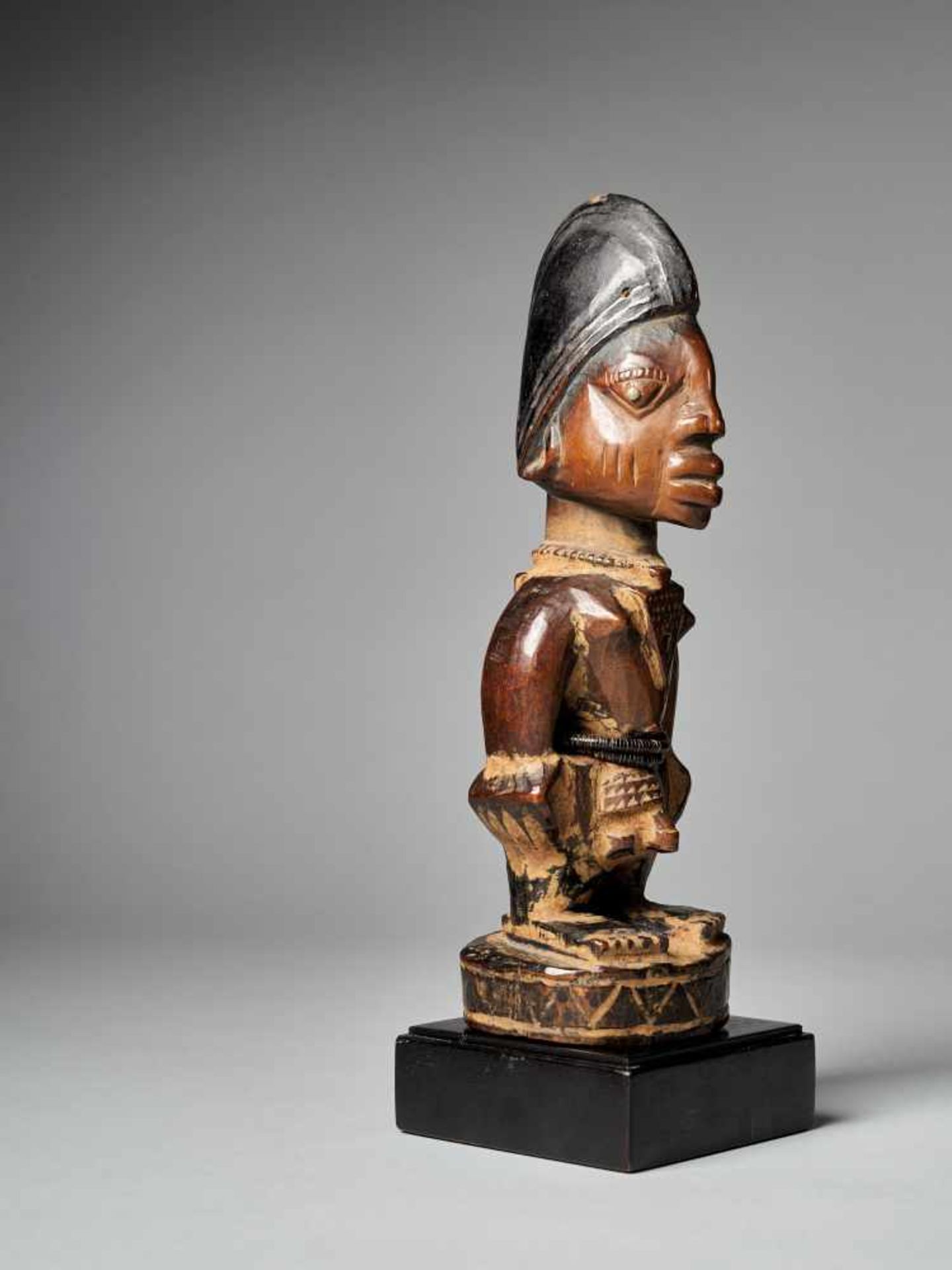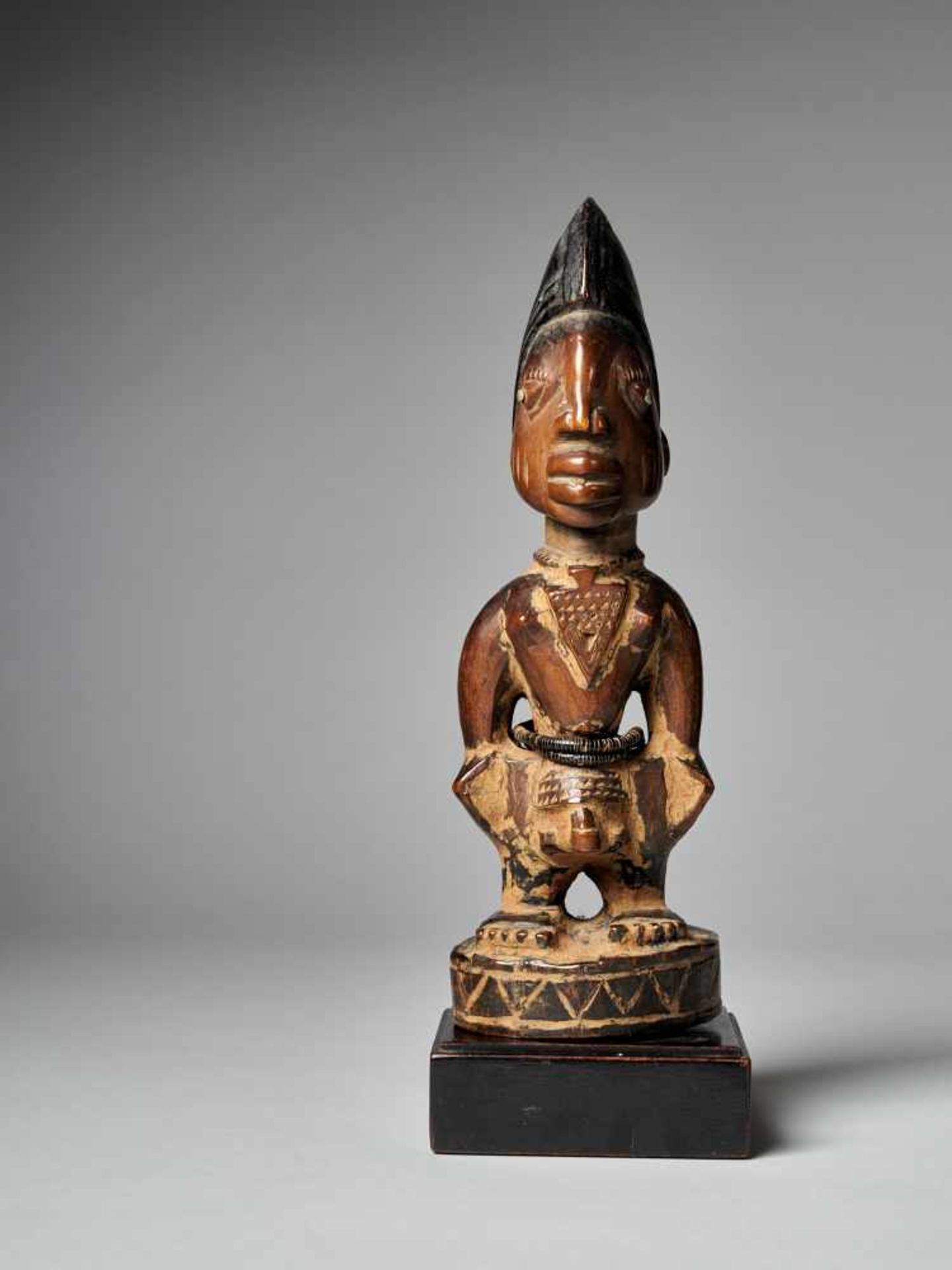33
Carved Twin figure 'Ibeji' - Yoruba, Nigeria - Tribal ArtA finely carved big Yoruba Male Ibeji
In Tribal Art 2
1/6
Das Auktionshaus hat für dieses Los keine Ergebnisse veröffentlicht
Brussels
Beschreibung
Carved Twin figure 'Ibeji' - Yoruba, Nigeria - Tribal Art
A finely carved big Yoruba Male Ibeji figure with tall headdress, expressive eyes ,original bead belt and heavy wear and polish from native use. Areas of encrusted cam wood powder between arms and around feet.Though the cause of the high rate of twin births among Yoruba women has not been established, the cultural grieving process is well documented and may be observed in the carving of a figure known as Ere Ibeji, which both represents the lost child and serves as a ritual point of contact with the soul of the deceased. The carving of the Ere Ibeji is commissioned under the guidance of an Ifa diviner, a Babalowo, whom the parents consult in selecting the particular artist who will do the work. The sculpture itself represents a deceased infant, but is carved with features and attributes of an adult. The sculptural features of genitalia, pubic hair, wide hips, developed breasts, gender specific facial scarification and mature coiffures exude an erotic sexuality, uncommon for infants. The completed ibeji figure is carved as an adult, rather than as the deceased infant, in a mythological form that depicts the concentrated calm of a Yoruba artist.When the carving of the Ere Ibeji is completed, the artist is given a feast and payment as determined by the Orishas. Once the figure is brought to the family dwelling, it is placed on a shrine dedicated to Elegba with the hope that the Orisha or soul, which was split in two parts when the twins were born, will now again reside in the figure that represents the dead twin. The sculpted figure is treated and cared for as if it were alive. It is rubbed in sacramental oil, washed, fed, clothed, sung to and prayed to. It is kept standing during the day, and is laid down at night. Often it will be dressed in the same clothing as the living twin, or be decorated in a beaded vest or shown with raised sandals, indicating possible royal connections. They attend to the figure as if it was their child, they feed and wash it. It will be constantly rubbed with indigo and red wood powder.The responsibility of caring for the Ibeji is borne by the mother and female family members of subsequent generations. The sculpture is expected to avert evil from the household, strengthen the manifestations of family love, stare down death, illuminate the pathway through the valley of immortality, and bring good fortune to all who treat it with respect and offer it tokens of affection.
Dated to the 1930's
Dimensions approx.26 x 9 x 8 cm
Tribal Art / African Art
291
A finely carved big Yoruba Male Ibeji figure with tall headdress, expressive eyes ,original bead belt and heavy wear and polish from native use. Areas of encrusted cam wood powder between arms and around feet.Though the cause of the high rate of twin births among Yoruba women has not been established, the cultural grieving process is well documented and may be observed in the carving of a figure known as Ere Ibeji, which both represents the lost child and serves as a ritual point of contact with the soul of the deceased. The carving of the Ere Ibeji is commissioned under the guidance of an Ifa diviner, a Babalowo, whom the parents consult in selecting the particular artist who will do the work. The sculpture itself represents a deceased infant, but is carved with features and attributes of an adult. The sculptural features of genitalia, pubic hair, wide hips, developed breasts, gender specific facial scarification and mature coiffures exude an erotic sexuality, uncommon for infants. The completed ibeji figure is carved as an adult, rather than as the deceased infant, in a mythological form that depicts the concentrated calm of a Yoruba artist.When the carving of the Ere Ibeji is completed, the artist is given a feast and payment as determined by the Orishas. Once the figure is brought to the family dwelling, it is placed on a shrine dedicated to Elegba with the hope that the Orisha or soul, which was split in two parts when the twins were born, will now again reside in the figure that represents the dead twin. The sculpted figure is treated and cared for as if it were alive. It is rubbed in sacramental oil, washed, fed, clothed, sung to and prayed to. It is kept standing during the day, and is laid down at night. Often it will be dressed in the same clothing as the living twin, or be decorated in a beaded vest or shown with raised sandals, indicating possible royal connections. They attend to the figure as if it was their child, they feed and wash it. It will be constantly rubbed with indigo and red wood powder.The responsibility of caring for the Ibeji is borne by the mother and female family members of subsequent generations. The sculpture is expected to avert evil from the household, strengthen the manifestations of family love, stare down death, illuminate the pathway through the valley of immortality, and bring good fortune to all who treat it with respect and offer it tokens of affection.
Dated to the 1930's
Dimensions approx.26 x 9 x 8 cm
Tribal Art / African Art
291
Auktionsdetails
Versand
AGB & Wichtige Informationen
Stellen Sie dem Verkäufer eine Frage
Carved Twin figure 'Ibeji' - Yoruba, Nigeria - Tribal Art
A finely carved big Yoruba Male Ibeji figure with tall headdress, expressive eyes ,original bead belt and heavy wear and polish from native use. Areas of encrusted cam wood powder between arms and around feet.Though the cause of the high rate of twin births among Yoruba women has not been established, the cultural grieving process is well documented and may be observed in the carving of a figure known as Ere Ibeji, which both represents the lost child and serves as a ritual point of contact with the soul of the deceased. The carving of the Ere Ibeji is commissioned under the guidance of an Ifa diviner, a Babalowo, whom the parents consult in selecting the particular artist who will do the work. The sculpture itself represents a deceased infant, but is carved with features and attributes of an adult. The sculptural features of genitalia, pubic hair, wide hips, developed breasts, gender specific facial scarification and mature coiffures exude an erotic sexuality, uncommon for infants. The completed ibeji figure is carved as an adult, rather than as the deceased infant, in a mythological form that depicts the concentrated calm of a Yoruba artist.When the carving of the Ere Ibeji is completed, the artist is given a feast and payment as determined by the Orishas. Once the figure is brought to the family dwelling, it is placed on a shrine dedicated to Elegba with the hope that the Orisha or soul, which was split in two parts when the twins were born, will now again reside in the figure that represents the dead twin. The sculpted figure is treated and cared for as if it were alive. It is rubbed in sacramental oil, washed, fed, clothed, sung to and prayed to. It is kept standing during the day, and is laid down at night. Often it will be dressed in the same clothing as the living twin, or be decorated in a beaded vest or shown with raised sandals, indicating possible royal connections. They attend to the figure as if it was their child, they feed and wash it. It will be constantly rubbed with indigo and red wood powder.The responsibility of caring for the Ibeji is borne by the mother and female family members of subsequent generations. The sculpture is expected to avert evil from the household, strengthen the manifestations of family love, stare down death, illuminate the pathway through the valley of immortality, and bring good fortune to all who treat it with respect and offer it tokens of affection.
Dated to the 1930's
Dimensions approx.26 x 9 x 8 cm
Tribal Art / African Art
291
A finely carved big Yoruba Male Ibeji figure with tall headdress, expressive eyes ,original bead belt and heavy wear and polish from native use. Areas of encrusted cam wood powder between arms and around feet.Though the cause of the high rate of twin births among Yoruba women has not been established, the cultural grieving process is well documented and may be observed in the carving of a figure known as Ere Ibeji, which both represents the lost child and serves as a ritual point of contact with the soul of the deceased. The carving of the Ere Ibeji is commissioned under the guidance of an Ifa diviner, a Babalowo, whom the parents consult in selecting the particular artist who will do the work. The sculpture itself represents a deceased infant, but is carved with features and attributes of an adult. The sculptural features of genitalia, pubic hair, wide hips, developed breasts, gender specific facial scarification and mature coiffures exude an erotic sexuality, uncommon for infants. The completed ibeji figure is carved as an adult, rather than as the deceased infant, in a mythological form that depicts the concentrated calm of a Yoruba artist.When the carving of the Ere Ibeji is completed, the artist is given a feast and payment as determined by the Orishas. Once the figure is brought to the family dwelling, it is placed on a shrine dedicated to Elegba with the hope that the Orisha or soul, which was split in two parts when the twins were born, will now again reside in the figure that represents the dead twin. The sculpted figure is treated and cared for as if it were alive. It is rubbed in sacramental oil, washed, fed, clothed, sung to and prayed to. It is kept standing during the day, and is laid down at night. Often it will be dressed in the same clothing as the living twin, or be decorated in a beaded vest or shown with raised sandals, indicating possible royal connections. They attend to the figure as if it was their child, they feed and wash it. It will be constantly rubbed with indigo and red wood powder.The responsibility of caring for the Ibeji is borne by the mother and female family members of subsequent generations. The sculpture is expected to avert evil from the household, strengthen the manifestations of family love, stare down death, illuminate the pathway through the valley of immortality, and bring good fortune to all who treat it with respect and offer it tokens of affection.
Dated to the 1930's
Dimensions approx.26 x 9 x 8 cm
Tribal Art / African Art
291
Tribal Art 2
Auktionsdatum
Ort der Versteigerung
Elsensesteenweg 204
Brussels
1050
Belgium
Für Ripple Art Auctions Versandinformtation bitte wählen Sie 1.














